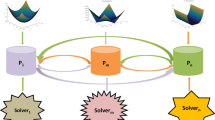Abstract
Memetic computing is a blooming research area, which treats memes as the fundamental building blocks of information transfer. Evolutionary multitasking is an emerging topic in memetic computation, which applies evolutionary algorithm to optimize multiple tasks at a time. A famous class of algorithms for evolutionary multitasking is the multi-factorial evolutionary algorithm (MFEA). Nevertheless, current MFEAs only consider problems with small number of tasks, resulting in a lack of effective information transfer strategy. This study proposes a framework for evolutionary multitasking, called the evolution of biocoenosis through symbiosis with fitness approximation (EBSFA). The EBSFA incorporates evolution of biocoenosis through symbiosis (EBS) with fitness approximation to ameliorate the information transfer. The improvement of EBSFA is three-fold, including (1) the adaptive control of information transfer among tasks, (2) the selection of individuals from the universal offspring pool for evaluation based on fitness approximation, and (3) an ensemble method for improving the accuracy of fitness approximation through k nearest neighbors. Experimental analysis verifies the effectiveness and efficiency of the proposed EBSFA, by comparison with an advanced single-tasking method, the covariance matrix adaptation evolution strategy (CMAES), an illustrious multitasking optimization method, the MFEA-II, and an evolutionary many-tasking method, the EBS on a set of many-tasking benchmark problems. The results show that EBSFA can gain nice solution quality and fast convergence speed. Further analysis validates the effectiveness of the proposed components on improving the information transfer.






Similar content being viewed by others
Explore related subjects
Discover the latest articles, news and stories from top researchers in related subjects.References
Bali KK, Ong YS, Gupta A, Tan PS (2019) Multifactorial evolutionary algorithm with online transfer parameter estimation: MFEA-II. IEEE Trans Evol Comput 24(1):69–83
Bali KK, Ong YS, Gupta A, Tan PS (2020) Cognizant multitasking in multiobjective multifactorial evolution: MO-MFEA-II. IEEE Trans Cybern, p 13
Broomhead D, Lowe D (1988) Radial basis functions, multi-variable functional interpolation and adaptive networks. In: RSRE memorandum/royal signals and radar establishment, vol 4148. Royals Signals and Radar Establishment
Carpenter W, Barthelemy J (1993) A comparison of polynomial approximations and artificial neural nets as response surfaces. Struct Optim 5:166–174
Chandra R, Gupta A, Ong YS, Goh CK (2016) Evolutionary multi-task learning for modular training of feedforward neural networks. In: Proceedings of international conference on neural information processing
Dorigo M, Maniezzo V, Colorni A (1996) Ant system: optimization by a colony of cooperating agents. IEEE Trans Syst Man Cybern Part B Cybern 26(1):29–41
Ebrahimi M, Farmani MR, Roshanian J (2011) Multidisciplinary design of a small satellite launch vehicle using particle swarm optimization. Struct Multidiscip Optim 44(6):773–784
Eiben AE, Smith JE (2003) Introduction to evolutionary computing. Natural computing. Springer, Berlin
Fonseca LG, Lemonge AC, Barbosa HJ (2012) A study on fitness inheritance for enhanced efficiency in real-coded genetic algorithms. In: Proceedings of IEEE congress on evolutionary computation, pp 1–8
Goldberg DE (1989) Genetic algorithms in search. Optimization and machine learning. Addison Wesley, Reading
Gong W, Zhou A, Cai Z (2015) A multioperator search strategy based on cheap surrogate models for evolutionary optimization. IEEE Trans Evol Comput 19(5):746–758
Gupta A, Mańdziuk J, Ong YS (2015) Evolutionary multitasking in bi-level optimization. Complex Intell Syst 1(1):83–95
Gupta A, Da B, Yuan Y, Ong YS (2016) On the emerging notion of evolutionary multitasking: a computational analog of cognitive multitasking, Adaptation and learning and optimization, vol 20. Springer, Berlin
Gupta A, Ong YS, Da B, Feng L, Handoko SD (2016) Landscape synergy in evolutionary multitasking. In: Proceedings of IEEE congress on evolutionary computation
Gupta A, Ong YS, Feng L (2016) Multifactorial evolution: toward evolutionary multitasking. IEEE Trans Evol Comput 20(3):343–357
Hansen N (2006) The CMA evolution strategy: a comparing review. In: Inza I, Bengoetxea E, Lozano JA, Nga PL (eds) Towards a new evolutionary computation, Advances in estimation of distribution algorithms. Springer, Berlin, pp 75–102
Hashimoto R, Ishibuchi H, Masuyama N, Nojima Y (2018) Analysis of evolutionary multi-tasking as an island model. In: Proceedings of the genetic and evolutionary computation conference companion, pp 1894–1897
Holland J (1975) Adaptation in natural and artificial systems. University of Michigan Press, Ann Arbor
Jin Y (2011) Surrogate-assisted evolutionary computation: recent advances and future challenges. Swarm Evol Comput 1:61–70
Lesh FH (1959) Multi-dimensional least-square polynomial curve fitting. Commun ACM 2(9):29–30
Liang JJ, Qu BY, Suganthan PN, Hernández-Díaz AG (2013) Problem definitions and evaluation criteria for the CEC 2013 special session and competition on real-parameter optimization. Nanyang Technological University, Technical report
Liaw RT, Ting CK (2016) Enhancing covariance matrix adaptation evolution strategy through fitness inheritance. In: Proceedings of the IEE congress on evolutionary computation, pp 1956–1963
Liaw RT, Ting CK (2017) Evolutionary many-tasking based on biocoenosis through symbiosis: a framework and benchmark problems. In: Proceedings of IEEE congress on evolutionary computation, pp 2266–2273
Liaw RT, Ting CK (2019) Evolutionary manytasking optimization based on symbiosis in biocoenosis. In: Proceedings of the AAAI conference on artificial intelligence, vol 33, pp 4295–4303
Liu B, Chen Q, Zhang Q, Gielen G, Grout V (2014) Behavioral study of the surrogate model-aware evolutionary search framework. In: Proceedings of IEEE congress on evolutionary computation, pp 715–722
Luong HN, Nguyen HTT, Ahn CW (2012) Entropy-based efficiency enhancement techniques for evolutionary algorithms. Inf Sci 188:100–120
Myers R, Montgomery D (1995) Response surface methodology. Wiley, New York
Ong YS, Zhou Z, Lim D (2006) Curse and blessing of uncertainty in evolutionary algorithm using approximation. In: Proceedings of IEEE congress on evolutionary computation, pp 2928–2935
Pelikan M, Sastry K (2004) Fitness inheritance in the Bayesian optimization algorithm. In: Proceedings of genetic and evolutionary computation conference, pp 48–59
Pilato C, Tumeo A, Palermo G, Ferrandi F, Lanzi PL, Sciuto D (2008) Improving evolutionary exploration to area-time optimization of FPGA designs. J Syst Archit 54(11):1046–1057
Pilato C, Loiacono D, Tumeo A, Ferrandi F, Lanzi PL, Sciuto D (2010) Speeding-up expensive evaluations in high-level synthesis using solution modeling and fitness inheritance. In: Proceedings of computational intelligence in expensive optimization problems, pp 701–723
Rechenberg I, Brand F, Hansen N, Herdy M, Ostermeier A (1995) Theorie der evolutionsstrategie–von der zufallssuche zur intelligenten strategie. Tagungsband zum Statusseminar des BMBF Bioinformatik G. Wolf and R. Schmidt and M. van der Meer
Regis RG (2014) Evolutionary programming for high-dimensional constrained expensive black-box optimization using radial basis functions. IEEE Trans Evol Comput 18(3):326–347
Sacks J, Welch WJ, Michell TJ, Wynn HP (1989) Design and analysis of computer experiments. Stat Sci 4:409–435
Sagarna R, Ong YS (2016) Concurrently searching branches in software tests generation through multitask evolution. In: Proceedings of IEEE symposium series on computational intelligence
Sastry K, Goldberg DE, Pelikan M (2001) Don’t evaluate, inherit. In: Proceedings of the genetic and evolutionary computation conference, pp 551–558
Sastry K, Goldberg DE, Pelikan M (2004) Efficiency enhancement of probabilistic model building genetic algorithms. Report 200420, IlliGAL
Sastry K, Pelikan M, Goldberg DE (2004) Efficiency enhancement of genetic algorithms via building-block-wise fitness estimation. In: Proceedings of IEEE congress on evolutionary computation, vol 1, pp 720–727
Sastry K, Lima CF, Goldberg DE (2006) Evaluation relaxation using substructural information and linear estimation. In: Proceedings of the genetic and evolutionary computation conference, pp 419–426
Shyy W, Tucker PK, Vaidyanathan R (2001) Response surface and neural network techniques for rocket engine injector optimization. J Propul Power 17(2):391–401
Smith RE, Dike BA, Stegmann SA (1995) Fitness inheritance in genetic algorithms. In: Proceedings of the ACM symposium on applied computing, pp 345–350
Strasser S, Sheppard J, Fortier N, Goodman R (2016) Factored evolutionary algorithms. IEEE Trans Evol Comput 21:281–293
Vapnik V (1998) Statistical learning theory. Wiley, New York
Wang TC, Liaw RT (2020) Multifactorial genetic fuzzy data mining for building membership functions. In: Proceedings of IEEE congress on evolutionary computation
Wen YW, Ting CK (2017) Parting ways and reallocating resources in evolutionary multitasking. In: Proceedings of IEEE congress on evolutionary computation, pp 2404–2411
Williams CKI, Rasmussen CE (1996) Gaussian processes for regression. In: Touretsky DS, Mozer MC, Hasselmo ME (eds) Advances in neural information processing systems, vol 8. MIT Press, Cambridge, pp 514–520
Zhou L, Feng L, Zhong J, Ong YS, Zhu Z, Sha E (2016) Evolutionary multitasking in combinatorial search spaces: a case study in capacitated vehicle routing problem. In: Proceedings of IEEE symposium series on computational intelligence
Acknowledgements
This work was supported by the Ministry of Science and Technology of Taiwan, under contracts MOST 109-2218-E-030-001-MY3, MOST 109-2634-F-007-020, and MOST 108-2634-F-007-012.
Author information
Authors and Affiliations
Corresponding authors
Additional information
Publisher's Note
Springer Nature remains neutral with regard to jurisdictional claims in published maps and institutional affiliations.
Rights and permissions
About this article
Cite this article
Liaw, RT., Ting, CK. Evolution of biocoenosis through symbiosis with fitness approximation for many-tasking optimization. Memetic Comp. 12, 399–417 (2020). https://doi.org/10.1007/s12293-020-00317-2
Received:
Accepted:
Published:
Issue Date:
DOI: https://doi.org/10.1007/s12293-020-00317-2




